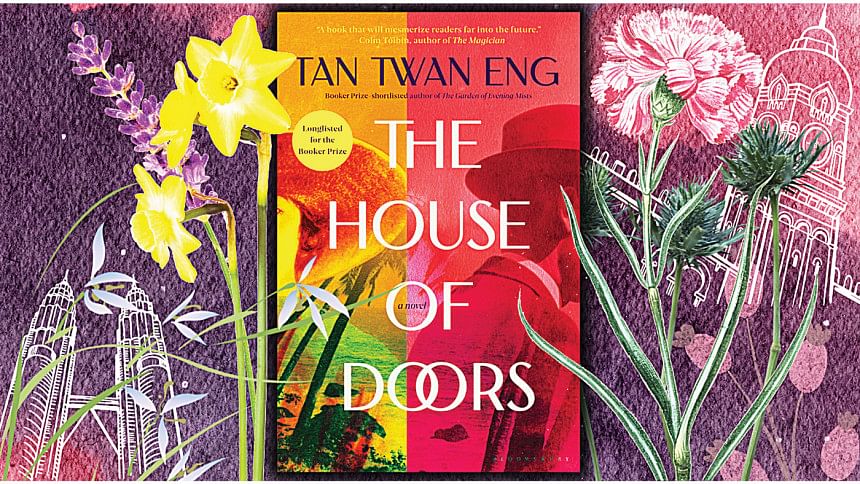When fiction and nonfiction create a literary supernova

When a book mentions one of my favourite authors, W. Somerset Maugham, and the short description suggests betrayal, intrigue, secret affairs, political uprisings, failed marriages, and a whodunnit, there's little I can do but take it. Longlisted for The Booker Prize 2023, The House of Doors by the Malaysian author, Tan Twan Eng, is a masterfully crafted literary work of fictional and nonfictional characters in a smudged sphere of fact and fiction. It shows Eng's length and depth of research and his imaginative prowess. Besides having Maugham somewhat in the centre stage, the author uses other real characters, real events, and characters from Maugham's novels and plays to create a story that spans over 30-odd years. Flashbacks of flashbacks with parallel plots, sprinkled with suspense and thrill are the ingredients for this unputdownable read. Immaculately structured with neat chapter divisions that mention the character from whose point of view the story is told, the year, and the location, the book ensures we don't get lost in the temporal and spatial maze.
Maugham, in the book, is the catalyst that leads the main character, Lesley Hamlyn, to spill the beans from her past and present, forming the bulk of the novel. The story begins and ends with Lesley in two different countries and continents. Maugham plays second fiddle and shares glimpses of his life—his sexual orientation, financial and marital straits, emotional dependence on an exploitative "secretary" who travels the world with him, and his special knack for sniffing out dark secrets and scandals which he turns into popular novels, short stories, and plays that keep him from falling into financial ruin.
Reeking of British colonialism, we see the white society in Malaya in the earlier decades of the 20th century living in the lap of luxury. Lesley and her lawyer husband, Robert, live in a mansion and are waited upon hand and foot by the natives. The short but powerful sketches of the nanny, rickshaw pullers, gardeners, and other house staff and those working in Penang sharply contrast their white masters and shed light on the vivid difference between the coloniser and the colonised. However, there is an undercurrent of rising consciousness against imperialism when Chinese revolutionary, Sun Yat Sen, is introduced. Lesley joins a clandestine group and lends help to the cause of breaking free from the current dynasty, signalling a desire to minimise class differences. During these meetings, she falls for Arthur, a fellow member and a Chinese, and carries on her affair in the eponymous house. The doors in The House of Doors lead Lesley to find peace, love, and refuge from her farcical marriage.
The theme of masks is explored through the characters and objects, most notably the doors. A door is synonymous with a mask and shows the outside world something that may be the opposite of what is concealed beyond it. In The House of Doors, we see it in the failed marriages of both Maugham and Robert. Both men are homosexuals, yet, they and their wives wear masks and are forced to pretend everything is fine to avoid societal judgments and ostracisation. Similarly, under the cover of The Philomatic Society, Sun Yat Sen carried on his revolutionary meetings and activities at a place with nondescript doors. And, finally, the slightly modified Chinese ideogram of a door inscribed on a Maugham book cover comes to Lesley in the guise of a letter and sets her on her path to reuniting with Arthur in Penang after 40 long years.
Letters also play a big role in The House of Doors. Through Lesley, Maugham gets the fodder and inspiration to write 'The Letter', a short story and play based on the true events of a murder case against Ethel Proudlock in 1911.
Among other things, the book explores the fragility and strength of relationships, human resilience and frailties, and the duality within us and the larger society. The atmospheric novel depicts the multicultural heritage of Malaya and its tropical and coastal landscape. It's loaded with Eastern symbolism and social, cultural, political, historical, and personal events, making it a fascinating read. A cerebral exercise in connecting the dots, I immensely enjoyed straddling the blurred boundaries of fact and fiction.
Zertab Quaderi is an SEO English content writer and social media marketing consultant by day and a reader of fiction and nonfiction books by night. In between, she travels and dabbles in watercolour painting.

 For all latest news, follow The Daily Star's Google News channel.
For all latest news, follow The Daily Star's Google News channel. 



Comments